This report serves to describe the mutational landscape and properties of a given individual set, as well as rank genes and genesets according to mutational significance. MutSig v2.0 and MutSigCV v0.9 merged result was used to generate the results found in this report.
-
Working with individual set: CESC-TP
-
Number of patients in set: 39
The input for this pipeline is a set of individuals with the following files associated for each:
-
An annotated .maf file describing the mutations called for the respective individual, and their properties.
-
A .wig file that contains information about the coverage of the sample.
-
MAF used for this analysis:CESC-TP.final_analysis_set.maf
-
Blacklist used for this analysis: pancan_mutation_blacklist.v14.hg19.txt
-
Significantly mutated genes (q ≤ 0.1): 5
-
Mutations seen in COSMIC: 35
-
Significantly mutated genes in COSMIC territory: 1
-
Significantly mutated genesets: 0
-
Read 39 MAFs of type "Broad"
-
Total number of mutations in input MAFs: 10020
-
After removing 5 mutations outside chr1-24: 10015
-
After removing 474 blacklisted mutations: 9541
-
After removing 599 noncoding mutations: 8942
-
Number of mutations before filtering: 8942
-
After removing 116 mutations outside gene set: 8826
-
After removing 17 mutations outside category set: 8809
Table 1. Get Full Table Table representing breakdown of mutations by type.
| type | count |
|---|---|
| Frame_Shift_Del | 98 |
| Frame_Shift_Ins | 62 |
| In_Frame_Del | 39 |
| In_Frame_Ins | 13 |
| Missense_Mutation | 5527 |
| Nonsense_Mutation | 473 |
| Nonstop_Mutation | 11 |
| Silent | 2482 |
| Splice_Site | 91 |
| Translation_Start_Site | 13 |
| Total | 8809 |
Table 2. Get Full Table A breakdown of mutation rates per category discovered for this individual set.
| category | n | N | rate | rate_per_mb | relative_rate | exp_ns_s_ratio |
|---|---|---|---|---|---|---|
| Tp*C->(T/G) | 3530 | 150569812 | 0.000023 | 23 | 4.2 | 3 |
| (A/C/G)p*C->(T/G) | 1102 | 425623126 | 2.6e-06 | 2.6 | 0.46 | 2.7 |
| C->A | 346 | 576192938 | 6e-07 | 0.6 | 0.11 | 4.4 |
| A->mut | 562 | 556925266 | 1e-06 | 1 | 0.18 | 3.9 |
| indel+null | 771 | 1133118204 | 6.8e-07 | 0.68 | 0.12 | NaN |
| double_null | 16 | 1133118204 | 1.4e-08 | 0.014 | 0.0025 | NaN |
| Total | 6327 | 1133118204 | 5.6e-06 | 5.6 | 1 | 3.5 |
The x axis represents the samples. The y axis represents the exons, one row per exon, and they are sorted by average coverage across samples. For exons with exactly the same average coverage, they are sorted next by the %GC of the exon. (The secondary sort is especially useful for the zero-coverage exons at the bottom). If the figure is unpopulated, then full coverage is assumed (e.g. MutSig CV doesn't use WIGs and assumes full coverage).
Figure 1.

Figure 2. Patients counts and rates file used to generate this plot: CESC-TP.patients.counts_and_rates.txt
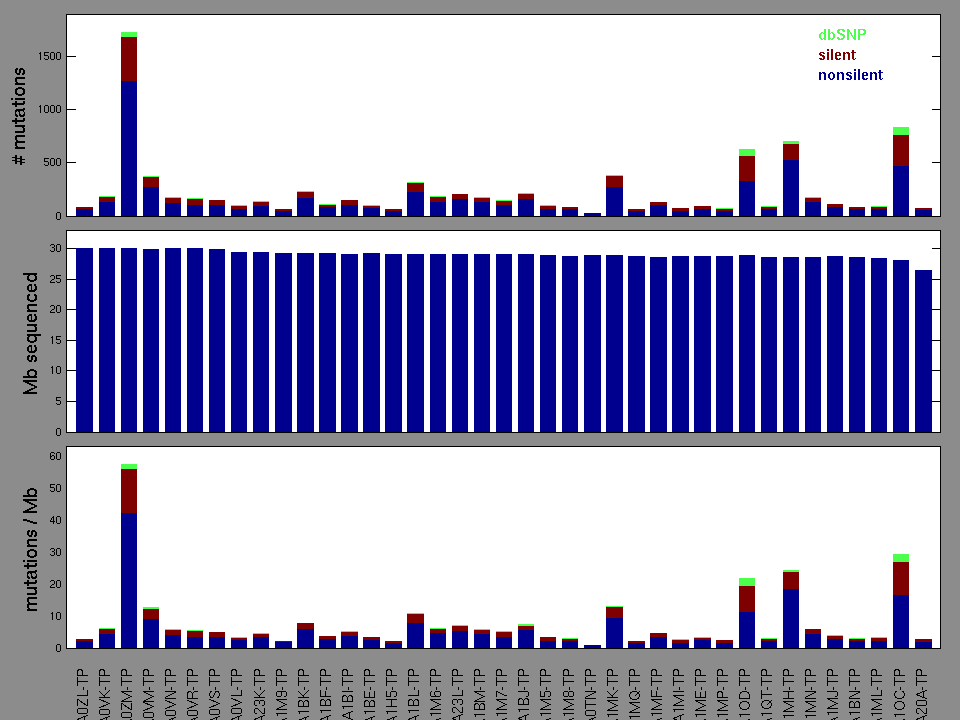
The mutation spectrum is depicted in the lego plots below in which the 96 possible mutation types are subdivided into six large blocks, color-coded to reflect the base substitution type. Each large block is further subdivided into the 16 possible pairs of 5' and 3' neighbors, as listed in the 4x4 trinucleotide context legend. The height of each block corresponds to the mutation frequency for that kind of mutation (counts of mutations normalized by the base coverage in a given bin). The shape of the spectrum is a signature for dominant mutational mechanisms in different tumor types.
Figure 3. Get High-res Image SNV Mutation rate lego plot for entire set. Each bin is normalized by base coverage for that bin. Colors represent the six SNV types on the upper right. The three-base context for each mutation is labeled in the 4x4 legend on the lower right. The fractional breakdown of SNV counts is shown in the pie chart on the upper left. If this figure is blank, not enough information was provided in the MAF to generate it.

Figure 4. Get High-res Image SNV Mutation rate lego plots for 4 slices of mutation allele fraction (0<=AF<0.1, 0.1<=AF<0.25, 0.25<=AF<0.5, & 0.5<=AF) . The color code and three-base context legends are the same as the previous figure. If this figure is blank, not enough information was provided in the MAF to generate it.

Figure 5. Get High-res Image The matrix in the center of the figure represents individual mutations in patient samples, color-coded by type of mutation, for the significantly mutated genes. The rate of synonymous and non-synonymous mutations is displayed at the top of the matrix. The barplot on the left of the matrix shows the number of mutations in each gene. The percentages represent the fraction of tumors with at least one mutation in the specified gene. The barplot to the right of the matrix displays the q-values for the most significantly mutated genes. The purple boxplots below the matrix (only displayed if required columns are present in the provided MAF) represent the distributions of allelic fractions observed in each sample. The plot at the bottom represents the base substitution distribution of individual samples, using the same categories that were used to calculate significance.
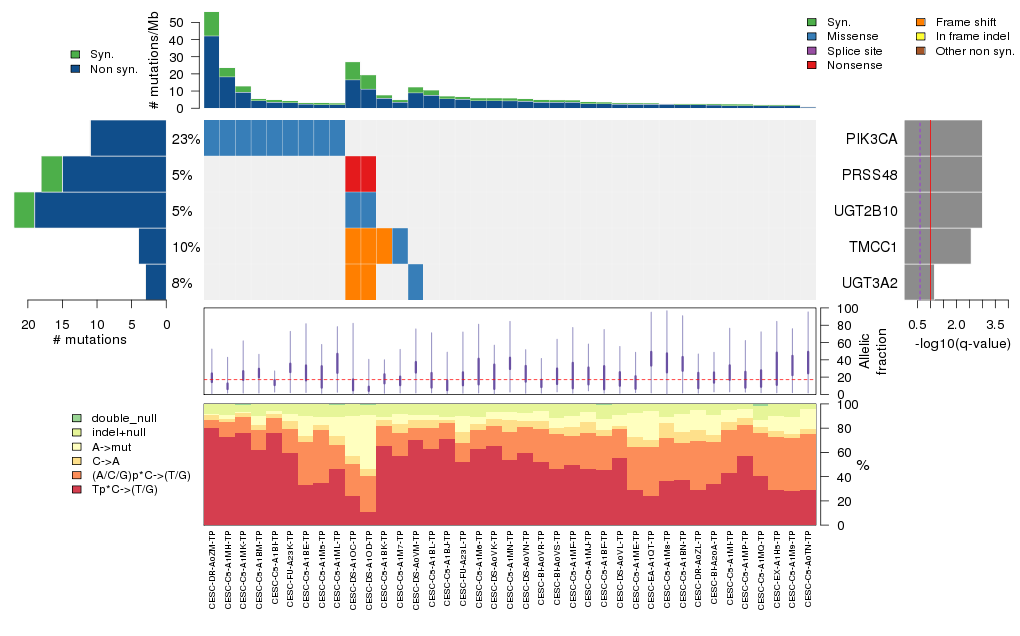
Column Descriptions:
-
N = number of sequenced bases in this gene across the individual set
-
n = number of (nonsilent) mutations in this gene across the individual set
-
npat = number of patients (individuals) with at least one nonsilent mutation
-
nsite = number of unique sites having a non-silent mutation
-
nsil = number of silent mutations in this gene across the individual set
-
n1 = number of nonsilent mutations of type: Tp*C->(T/G)
-
n2 = number of nonsilent mutations of type: (A/C/G)p*C->(T/G)
-
n3 = number of nonsilent mutations of type: C->A
-
n4 = number of nonsilent mutations of type: A->mut
-
n5 = number of nonsilent mutations of type: indel+null
-
n6 = number of nonsilent mutations of type: double_null
-
p_cons = p-value for enrichment of mutations at evolutionarily most-conserved sites in gene
-
p_joint = p-value for clustering + conservation
-
p = p-value (overall)
-
q = q-value, False Discovery Rate (Benjamini-Hochberg procedure)
Table 3. Get Full Table A Ranked List of Significantly Mutated Genes. Number of significant genes found: 5. Number of genes displayed: 35. Click on a gene name to display its stick figure depicting the distribution of mutations and mutation types across the chosen gene (this feature may not be available for all significant genes).
| rank | gene | description | N | n | npat | nsite | nsil | n1 | n2 | n3 | n4 | n5 | n6 | p_clust | p_cons | p_joint | p_cv | p | q |
|---|---|---|---|---|---|---|---|---|---|---|---|---|---|---|---|---|---|---|---|
| 1 | PIK3CA | phosphoinositide-3-kinase, catalytic, alpha polypeptide | 126650 | 11 | 9 | 4 | 0 | 10 | 0 | 0 | 1 | 0 | 0 | 8e-06 | 0.017 | 0 | 0.00038 | 0 | 0 |
| 2 | PRSS48 | protease, serine, 48 | 38982 | 15 | 2 | 8 | 3 | 0 | 2 | 2 | 9 | 2 | 0 | 0 | 0.96 | 0 | 0.27 | 0 | 0 |
| 3 | UGT2B10 | UDP glucuronosyltransferase 2 family, polypeptide B10 | 122318 | 19 | 2 | 13 | 3 | 2 | 3 | 1 | 13 | 0 | 0 | 0 | 0.99 | 0 | 0.99 | 0 | 0 |
| 4 | TMCC1 | transmembrane and coiled-coil domain family 1 | 77000 | 4 | 4 | 3 | 0 | 0 | 0 | 1 | 0 | 3 | 0 | 0.00013 | 0.086 | 9e-05 | 0.00023 | 3.8e-07 | 0.0017 |
| 5 | UGT3A2 | UDP glycosyltransferase 3 family, polypeptide A2 | 62290 | 3 | 3 | 2 | 0 | 1 | 0 | 0 | 0 | 2 | 0 | 0.016 | 0.0019 | 0.00059 | 0.0022 | 0.000019 | 0.069 |
| 6 | MAPK1 | mitogen-activated protein kinase 1 | 38660 | 3 | 3 | 1 | 0 | 3 | 0 | 0 | 0 | 0 | 0 | 0.00032 | 0.19 | 0.00065 | 0.0046 | 0.000041 | 0.12 |
| 7 | PRB2 | proline-rich protein BstNI subfamily 2 | 49240 | 5 | 4 | 4 | 0 | 0 | 0 | 0 | 1 | 4 | 0 | 0.29 | 0.28 | 0.33 | 0.000036 | 0.00015 | 0.37 |
| 8 | PLAC4 | placenta-specific 4 | 7160 | 2 | 2 | 1 | 0 | 0 | 0 | 0 | 0 | 2 | 0 | 0.021 | 0.31 | 0.083 | 0.00019 | 0.00019 | 0.43 |
| 9 | OR10G8 | olfactory receptor, family 10, subfamily G, member 8 | 36617 | 16 | 2 | 10 | 13 | 0 | 10 | 0 | 5 | 1 | 0 | 2.4e-06 | 1 | 0.000017 | 0.95 | 0.0002 | 0.43 |
| 10 | PTEN | phosphatase and tensin homolog (mutated in multiple advanced cancers 1) | 45935 | 3 | 3 | 3 | 0 | 0 | 0 | 0 | 0 | 3 | 0 | 0.28 | 0.82 | 0.39 | 0.00015 | 0.00064 | 1 |
| 11 | NFE2L2 | nuclear factor (erythroid-derived 2)-like 2 | 69545 | 7 | 6 | 6 | 0 | 4 | 0 | 0 | 1 | 2 | 0 | 0.49 | 0.041 | 0.16 | 0.0004 | 0.00067 | 1 |
| 12 | ITGAX | integrin, alpha X (complement component 3 receptor 4 subunit) | 131027 | 8 | 4 | 6 | 6 | 2 | 2 | 0 | 3 | 1 | 0 | 0.000038 | 0.52 | 0.00012 | 0.74 | 0.00093 | 1 |
| 13 | RAET1L | retinoic acid early transcript 1L | 25451 | 5 | 2 | 4 | 0 | 1 | 1 | 0 | 3 | 0 | 0 | 0.00047 | 0.45 | 0.0021 | 0.084 | 0.0017 | 1 |
| 14 | TREML4 | triggering receptor expressed on myeloid cells-like 4 | 23897 | 5 | 2 | 4 | 3 | 0 | 3 | 0 | 1 | 1 | 0 | 0.008 | 0.83 | 0.019 | 0.011 | 0.0021 | 1 |
| 15 | SEH1L | SEH1-like (S. cerevisiae) | 50533 | 2 | 2 | 1 | 0 | 0 | 0 | 0 | 0 | 2 | 0 | 0.0098 | 0.0074 | 0.039 | 0.0059 | 0.0022 | 1 |
| 16 | USP26 | ubiquitin specific peptidase 26 | 107055 | 2 | 2 | 2 | 0 | 1 | 0 | 0 | 0 | 1 | 0 | 0.045 | 0.0051 | 0.0026 | 0.12 | 0.0029 | 1 |
| 17 | XAGE5 | X antigen family, member 5 | 13377 | 3 | 2 | 3 | 0 | 0 | 0 | 0 | 2 | 1 | 0 | 0.089 | 0.33 | 0.12 | 0.0069 | 0.0065 | 1 |
| 18 | CPNE3 | copine III | 64568 | 3 | 2 | 3 | 0 | 2 | 0 | 0 | 0 | 1 | 0 | 0.00072 | 0.97 | 0.0019 | 0.45 | 0.0068 | 1 |
| 19 | SPANXN5 | SPANX family, member N5 | 8853 | 1 | 1 | 1 | 0 | 0 | 0 | 0 | 0 | 1 | 0 | NaN | NaN | NaN | 0.0069 | 0.0069 | 1 |
| 20 | C20orf134 | chromosome 20 open reading frame 134 | 15064 | 2 | 2 | 2 | 0 | 1 | 0 | 0 | 0 | 1 | 0 | 0.081 | 0.94 | 0.11 | 0.0078 | 0.0071 | 1 |
| 21 | PTH2 | parathyroid hormone 2 | 8040 | 2 | 2 | 2 | 0 | 1 | 0 | 1 | 0 | 0 | 0 | 0.7 | 0.048 | 0.028 | 0.032 | 0.0072 | 1 |
| 22 | ZNF645 | zinc finger protein 645 | 49998 | 2 | 2 | 1 | 0 | 0 | 2 | 0 | 0 | 0 | 0 | 0.013 | 0.063 | 0.015 | 0.066 | 0.0077 | 1 |
| 23 | LCE1C | late cornified envelope 1C | 14077 | 4 | 2 | 2 | 9 | 0 | 4 | 0 | 0 | 0 | 0 | 0.0037 | 0.98 | 0.0068 | 0.16 | 0.0087 | 1 |
| 24 | FETUB | fetuin B | 45815 | 2 | 2 | 2 | 0 | 1 | 0 | 0 | 1 | 0 | 0 | 0.088 | 0.024 | 0.0085 | 0.13 | 0.0089 | 1 |
| 25 | TMEM47 | transmembrane protein 47 | 11233 | 1 | 1 | 1 | 0 | 0 | 0 | 0 | 0 | 1 | 0 | NaN | NaN | NaN | 0.0093 | 0.0093 | 1 |
| 26 | IL13RA1 | interleukin 13 receptor, alpha 1 | 48201 | 2 | 2 | 1 | 0 | 0 | 0 | 0 | 0 | 2 | 0 | 0.01 | 0.62 | 0.24 | 0.0051 | 0.0093 | 1 |
| 27 | TCEAL2 | transcription elongation factor A (SII)-like 2 | 26340 | 3 | 1 | 3 | 1 | 1 | 0 | 0 | 2 | 0 | 0 | 0.00092 | 0.94 | 0.004 | 0.32 | 0.0098 | 1 |
| 28 | C11orf52 | chromosome 11 open reading frame 52 | 14969 | 2 | 2 | 2 | 0 | 1 | 0 | 0 | 0 | 1 | 0 | 0.42 | 0.56 | 0.83 | 0.0019 | 0.012 | 1 |
| 29 | IFNGR2 | interferon gamma receptor 2 (interferon gamma transducer 1) | 37635 | 2 | 2 | 2 | 0 | 0 | 0 | 0 | 0 | 2 | 0 | 0.2 | 0.59 | 0.42 | 0.004 | 0.012 | 1 |
| 30 | WDR44 | WD repeat domain 44 | 109831 | 2 | 2 | 2 | 0 | 1 | 0 | 0 | 0 | 1 | 0 | 0.11 | 0.01 | 0.019 | 0.1 | 0.014 | 1 |
| 31 | MTL5 | metallothionein-like 5, testis-specific (tesmin) | 48655 | 2 | 2 | 2 | 0 | 0 | 0 | 0 | 0 | 2 | 0 | 0.45 | 0.16 | 0.25 | 0.0078 | 0.014 | 1 |
| 32 | TIE1 | tyrosine kinase with immunoglobulin-like and EGF-like domains 1 | 125328 | 4 | 3 | 4 | 0 | 0 | 2 | 1 | 0 | 1 | 0 | 0.066 | 0.03 | 0.016 | 0.14 | 0.015 | 1 |
| 33 | CTNNBIP1 | catenin, beta interacting protein 1 | 6478 | 1 | 1 | 1 | 0 | 0 | 0 | 0 | 0 | 1 | 0 | NaN | NaN | NaN | 0.017 | 0.017 | 1 |
| 34 | FAM49A | family with sequence similarity 49, member A | 39076 | 2 | 2 | 2 | 0 | 0 | 1 | 0 | 1 | 0 | 0 | 0.015 | 0.54 | 0.026 | 0.11 | 0.019 | 1 |
| 35 | ASH1L | ash1 (absent, small, or homeotic)-like (Drosophila) | 350984 | 4 | 2 | 4 | 1 | 2 | 0 | 0 | 1 | 1 | 0 | 0.00091 | 0.98 | 0.0028 | 0.98 | 0.019 | 1 |
Figure S1. This figure depicts the distribution of mutations and mutation types across the PIK3CA significant gene.

Figure S2. This figure depicts the distribution of mutations and mutation types across the PRSS48 significant gene.

Figure S3. This figure depicts the distribution of mutations and mutation types across the UGT2B10 significant gene.
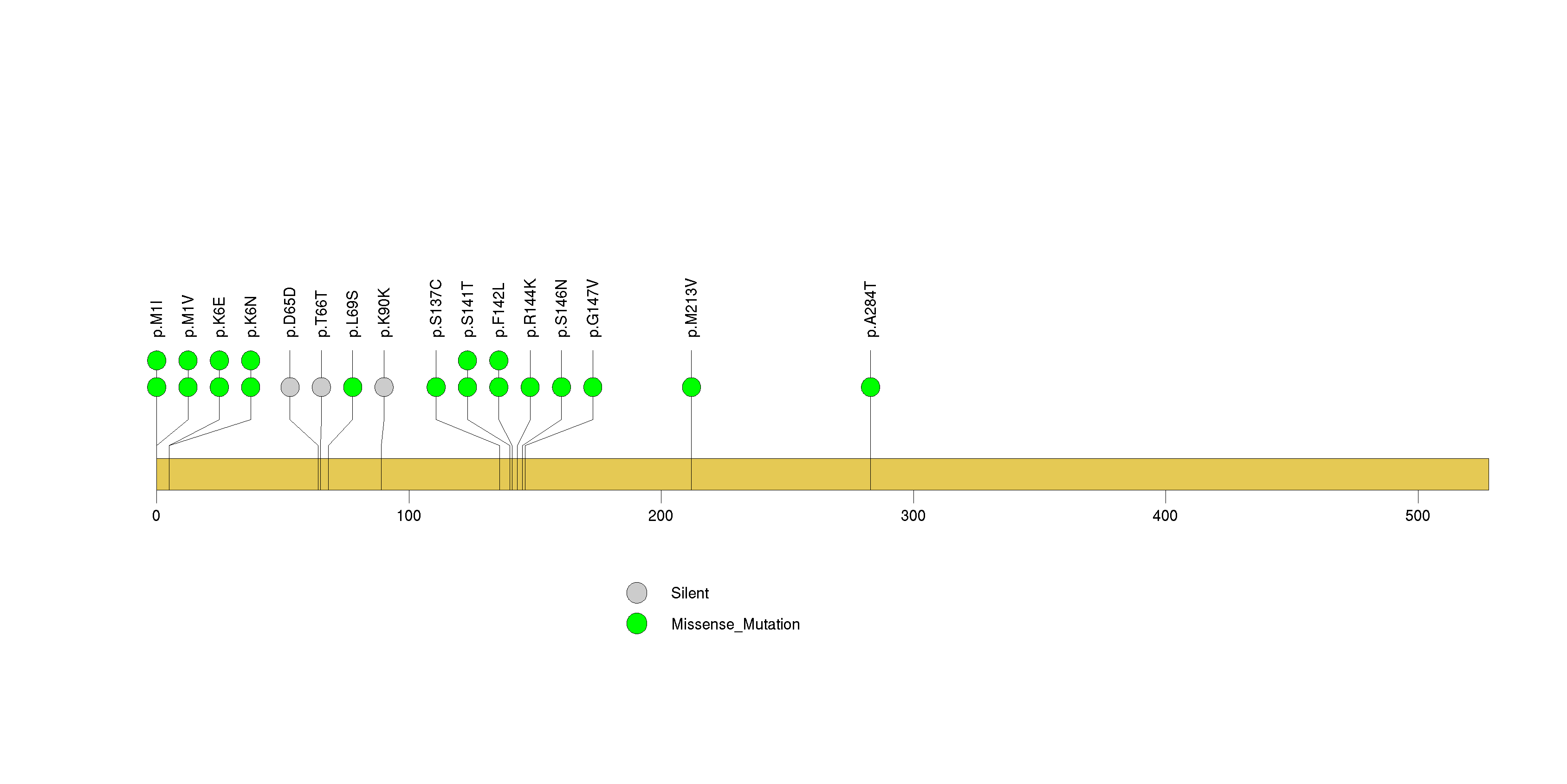
Figure S4. This figure depicts the distribution of mutations and mutation types across the TMCC1 significant gene.
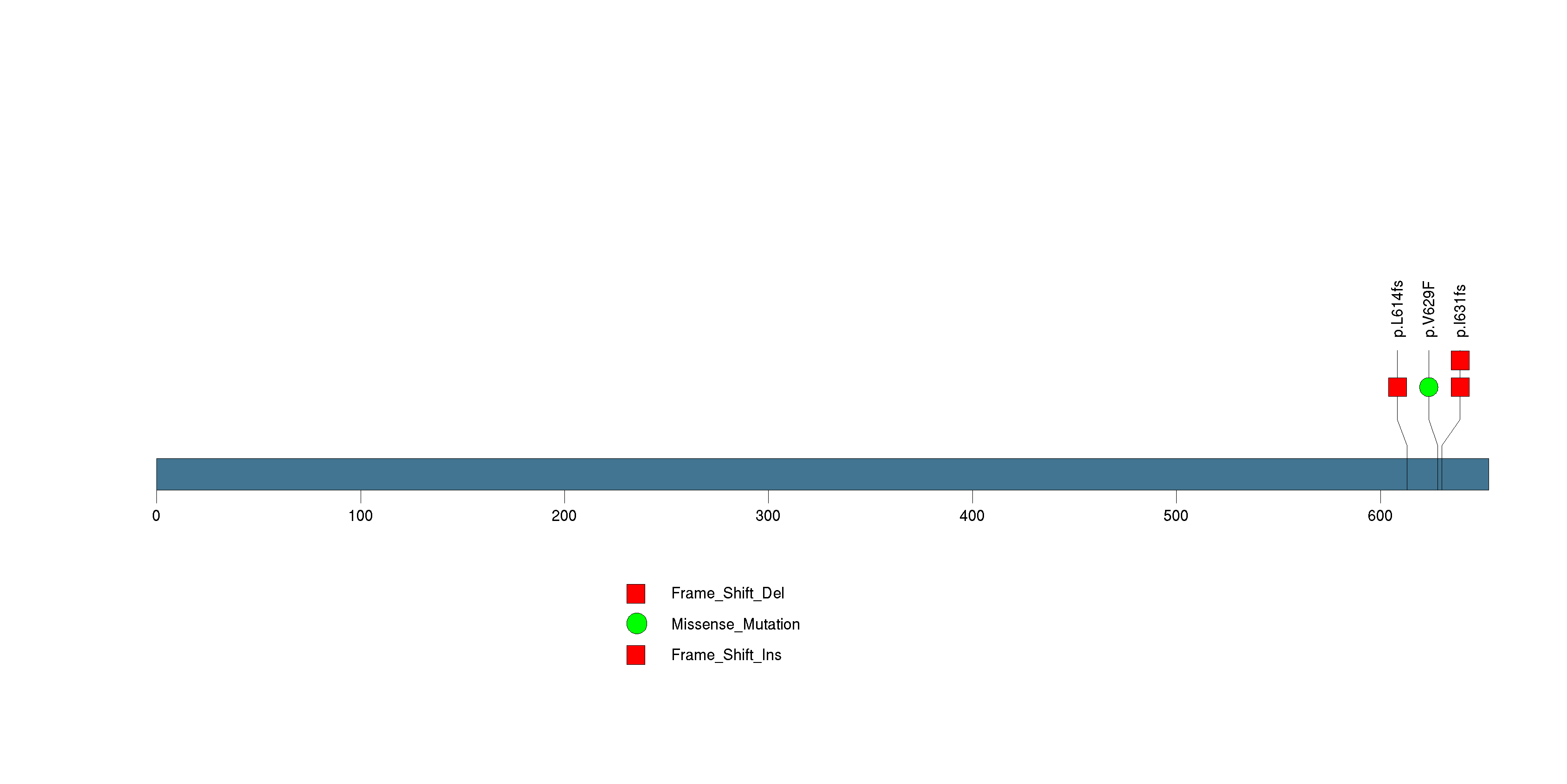
Figure S5. This figure depicts the distribution of mutations and mutation types across the UGT3A2 significant gene.
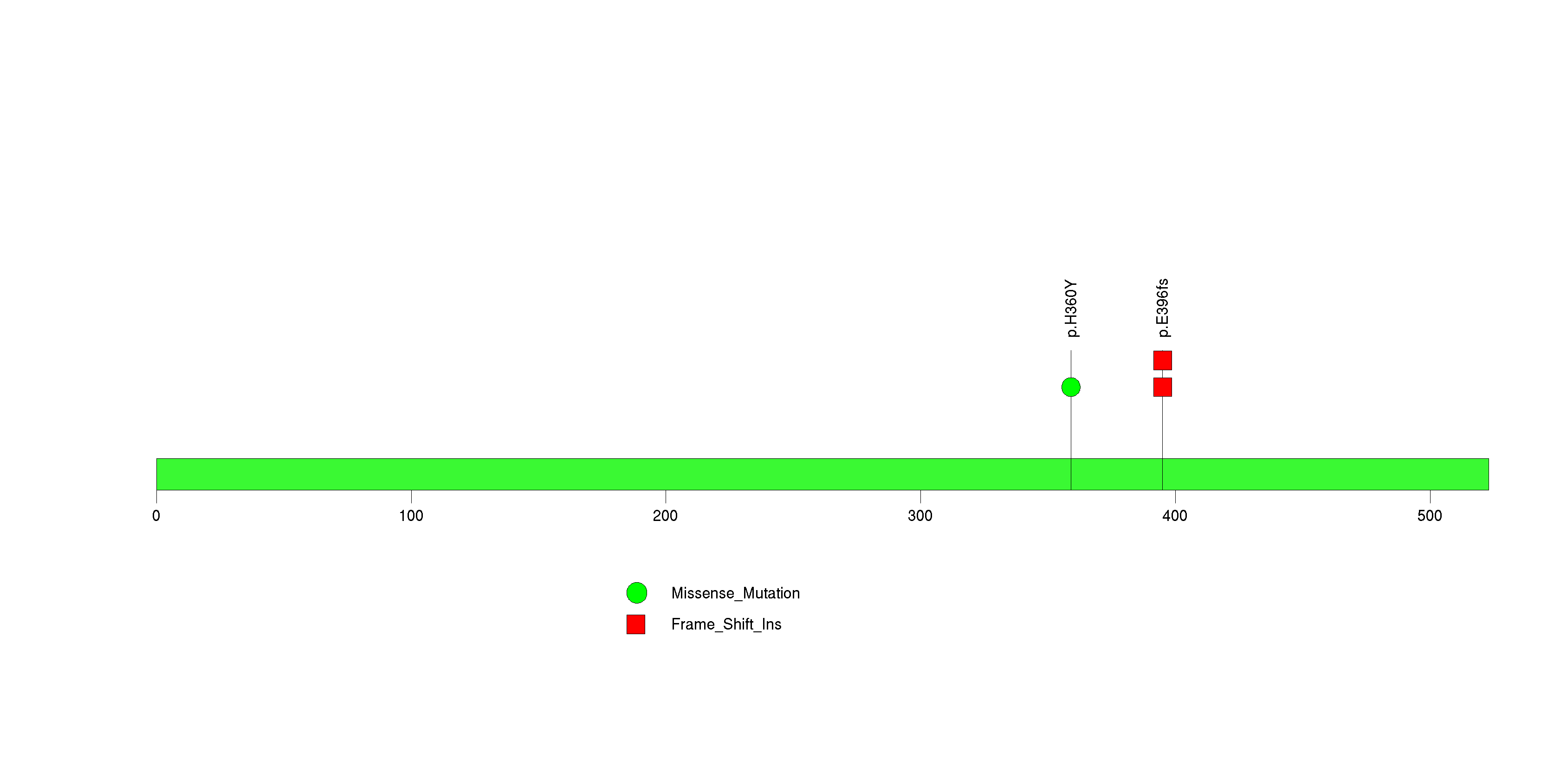
In this analysis, COSMIC is used as a filter to increase power by restricting the territory of each gene. Cosmic version: v48.
Table 4. Get Full Table Significantly mutated genes (COSMIC territory only). To access the database please go to: COSMIC. Number of significant genes found: 1. Number of genes displayed: 10
| rank | gene | description | n | cos | n_cos | N_cos | cos_ev | p | q |
|---|---|---|---|---|---|---|---|---|---|
| 1 | PIK3CA | phosphoinositide-3-kinase, catalytic, alpha polypeptide | 11 | 220 | 8 | 8580 | 3939 | 0 | 0 |
| 2 | ATL2 | atlastin GTPase 2 | 1 | 1 | 1 | 39 | 1 | 0.00022 | 0.16 |
| 3 | EDA | ectodysplasin A | 1 | 1 | 1 | 39 | 1 | 0.00022 | 0.16 |
| 4 | KIAA1024 | KIAA1024 | 2 | 1 | 1 | 39 | 1 | 0.00022 | 0.16 |
| 5 | MAPK11 | mitogen-activated protein kinase 11 | 1 | 1 | 1 | 39 | 1 | 0.00022 | 0.16 |
| 6 | SUV39H2 | suppressor of variegation 3-9 homolog 2 (Drosophila) | 1 | 1 | 1 | 39 | 2 | 0.00022 | 0.16 |
| 7 | ALS2 | amyotrophic lateral sclerosis 2 (juvenile) | 2 | 3 | 1 | 117 | 1 | 0.00065 | 0.22 |
| 8 | EPHA10 | EPH receptor A10 | 1 | 3 | 1 | 117 | 1 | 0.00065 | 0.22 |
| 9 | IFITM3 | interferon induced transmembrane protein 3 (1-8U) | 5 | 3 | 1 | 117 | 1 | 0.00065 | 0.22 |
| 10 | ITIH5L | inter-alpha (globulin) inhibitor H5-like | 1 | 3 | 1 | 117 | 1 | 0.00065 | 0.22 |
Note:
n - number of (nonsilent) mutations in this gene across the individual set.
cos = number of unique mutated sites in this gene in COSMIC
n_cos = overlap between n and cos.
N_cos = number of individuals times cos.
cos_ev = total evidence: number of reports in COSMIC for mutations seen in this gene.
p = p-value for seeing the observed amount of overlap in this gene)
q = q-value, False Discovery Rate (Benjamini-Hochberg procedure)
Table 5. Get Full Table A Ranked List of Significantly Mutated Genesets. (Source: MSigDB GSEA Cannonical Pathway Set).Number of significant genesets found: 0. Number of genesets displayed: 10
| rank | geneset | description | genes | N_genes | mut_tally | N | n | npat | nsite | nsil | n1 | n2 | n3 | n4 | n5 | n6 | p_ns_s | p | q |
|---|---|---|---|---|---|---|---|---|---|---|---|---|---|---|---|---|---|---|---|
| 1 | PAR1PATHWAY | Activated extracellular thrombin cleaves and activates the G-protein coupled receptors PAR1 and PAR4, which activate platelets. | ADCY1, ARHA, ARHGEF1, F2, F2R, F2RL3, GNA12, GNA13, GNAI1, GNAQ, GNB1, GNGT1, MAP3K7, PIK3CA, PIK3R1, PLCB1, PPP1R12B, PRKCA, PRKCB1, PTK2B, ROCK1 | 19 | ADCY1(1), ARHGEF1(1), F2R(1), F2RL3(2), GNA13(1), PIK3CA(11), PIK3R1(1), PPP1R12B(1), PRKCA(1), ROCK1(3) | 1478575 | 23 | 13 | 16 | 1 | 16 | 3 | 1 | 2 | 0 | 1 | 0.011 | 0.00041 | 0.12 |
| 2 | ACHPATHWAY | Nicotinic acetylcholine receptors are ligand-gated ion channels that primarily mediate neuromuscular signaling and may inhibit neuronal apoptosis via the AKT pathway. | AKT1, BAD, CHRNB1, CHRNG, FOXO3A, MUSK, PIK3CA, PIK3R1, PTK2, PTK2B, RAPSN, SRC, TERT, TNFSF6, YWHAH | 13 | CHRNG(1), MUSK(1), PIK3CA(11), PIK3R1(1), PTK2(1) | 935251 | 15 | 11 | 8 | 1 | 11 | 0 | 1 | 2 | 1 | 0 | 0.053 | 0.00044 | 0.12 |
| 3 | ERK5PATHWAY | Signaling between a tissue and its innervating axon stimulates retrograde transport via Trk receptors, which activate Erk5, which induces transcription of anti-apoptotic factors. | AKT1, CREB1, GRB2, HRAS, MAPK1, MAPK3, MAPK7, MEF2A, MEF2B, MEF2C, MEF2D, NTRK1, PIK3CA, PIK3R1, PLCG1, RPS6KA1, SHC1 | 17 | MAPK1(3), MAPK7(1), MEF2C(1), PIK3CA(11), PIK3R1(1), RPS6KA1(2) | 1088110 | 19 | 11 | 10 | 1 | 14 | 1 | 0 | 3 | 1 | 0 | 0.03 | 0.00069 | 0.12 |
| 4 | GCRPATHWAY | Corticosteroids activate the glucocorticoid receptor (GR), which inhibits NF-kB and activates Annexin-1, thus inhibiting the inflammatory response. | ADRB2, AKT1, ANXA1, CALM1, CALM2, CALM3, CRN, GNAS, GNB1, GNGT1, HSPCA, NFKB1, NOS3, NPPA, NR3C1, PIK3CA, PIK3R1, RELA, SYT1 | 17 | CALM1(1), CALM3(1), NPPA(1), PIK3CA(11), PIK3R1(1), SYT1(1) | 1019231 | 16 | 11 | 9 | 0 | 12 | 1 | 1 | 2 | 0 | 0 | 0.018 | 0.00078 | 0.12 |
| 5 | PTENPATHWAY | PTEN suppresses AKT-induced cell proliferation and antagonizes the action of PI3K. | AKT1, BCAR1, CDKN1B, FOXO3A, GRB2, ILK, ITGB1, MAPK1, MAPK3, PDK2, PDPK1, PIK3CA, PIK3R1, PTEN, PTK2, SHC1, SOS1, TNFSF6 | 16 | MAPK1(3), PIK3CA(11), PIK3R1(1), PTEN(3), PTK2(1), SOS1(1) | 1108069 | 20 | 11 | 11 | 0 | 15 | 0 | 0 | 2 | 3 | 0 | 0.0079 | 0.0014 | 0.15 |
| 6 | CTLA4PATHWAY | T cell activation requires interaction with an antigen-MHC-I complex on an antigen-presenting cell (APC), as well as CD28 interaction with the APC's CD80 or 86. | CD28, CD3D, CD3E, CD3G, CD3Z, CD80, CD86, CTLA4, GRB2, HLA-DRA, HLA-DRB1, ICOS, ICOSL, IL2, ITK, LCK, PIK3CA, PIK3R1, PTPN11, TRA@, TRB@ | 17 | CD86(1), ITK(1), PIK3CA(11), PIK3R1(1), PTPN11(1) | 739491 | 15 | 9 | 8 | 0 | 12 | 1 | 0 | 2 | 0 | 0 | 0.018 | 0.0014 | 0.15 |
| 7 | ST_TYPE_I_INTERFERON_PATHWAY | Type I interferon is an antiviral cytokine that induces a JAK-STAT type pathway leading to ISGF3 activation and a cellular antiviral response. | IFNAR1, IFNB1, ISGF3G, JAK1, PTPRU, REG1A, STAT1, STAT2, TYK2 | 8 | IFNAR1(2), PTPRU(1), REG1A(1), STAT1(3), TYK2(3) | 723179 | 10 | 10 | 10 | 1 | 7 | 3 | 0 | 0 | 0 | 0 | 0.12 | 0.0018 | 0.16 |
| 8 | IFNGPATHWAY | IFN gamma signaling pathway | IFNG, IFNGR1, IFNGR2, JAK1, JAK2, STAT1 | 6 | IFNGR1(2), IFNGR2(2), JAK2(1), STAT1(3) | 473117 | 8 | 7 | 8 | 1 | 4 | 1 | 0 | 0 | 3 | 0 | 0.48 | 0.0021 | 0.16 |
| 9 | ARFPATHWAY | Cyclin-dependent kinase inhibitor 2A is a tumor suppressor that induces G1 arrest and can activate the p53 pathway, leading to G2/M arrest. | ABL1, CDKN2A, E2F1, MDM2, MYC, PIK3CA, PIK3R1, POLR1A, POLR1B, POLR1C, POLR1D, RAC1, RB1, TBX2, TP53, TWIST1 | 16 | ABL1(1), PIK3CA(11), PIK3R1(1), POLR1A(2), POLR1C(2), TP53(2) | 1168503 | 19 | 14 | 12 | 2 | 13 | 0 | 0 | 4 | 2 | 0 | 0.13 | 0.0027 | 0.18 |
| 10 | PLCPATHWAY | Phospholipase C hydrolyzes the membrane lipid PIP2 to DAG, which activates protein kinase C, and IP3, which causes calcium influx. | AKT1, PIK3CA, PIK3R1, PLCB1, PLCG1, PRKCA, PRKCB1, VAV1 | 7 | PIK3CA(11), PIK3R1(1), PRKCA(1) | 739813 | 13 | 9 | 6 | 1 | 11 | 0 | 0 | 2 | 0 | 0 | 0.13 | 0.0029 | 0.18 |
In brief, we tabulate the number of mutations and the number of covered bases for each gene. The counts are broken down by mutation context category: four context categories that are discovered by MutSig, and one for indel and 'null' mutations, which include indels, nonsense mutations, splice-site mutations, and non-stop (read-through) mutations. For each gene, we calculate the probability of seeing the observed constellation of mutations, i.e. the product P1 x P2 x ... x Pm, or a more extreme one, given the background mutation rates calculated across the dataset. [1]
In addition to the links below, the full results of the analysis summarized in this report can also be downloaded programmatically using firehose_get, or interactively from either the Broad GDAC website or TCGA Data Coordination Center Portal.